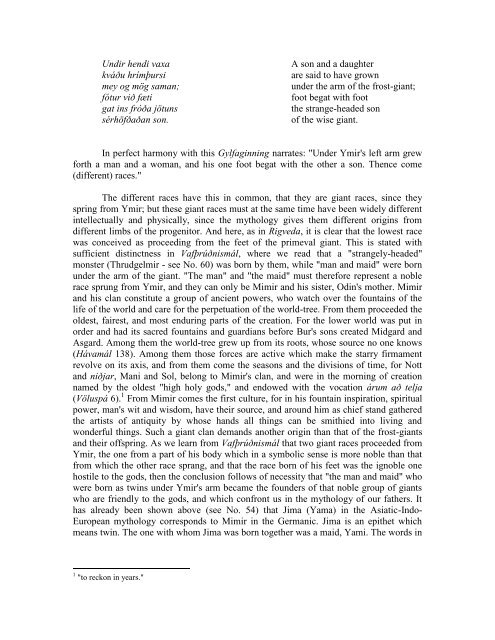Chapters 44-95 - Germanic Mythology
Chapters 44-95 - Germanic Mythology
Chapters 44-95 - Germanic Mythology
You also want an ePaper? Increase the reach of your titles
YUMPU automatically turns print PDFs into web optimized ePapers that Google loves.
Undir hendi vaxa<br />
kváðu hrímþursi<br />
mey og mög saman;<br />
fótur við fæti<br />
gat ins fróða jötuns<br />
sérhöfðaðan son.<br />
A son and a daughter<br />
are said to have grown<br />
under the arm of the frost-giant;<br />
foot begat with foot<br />
the strange-headed son<br />
of the wise giant.<br />
In perfect harmony with this Gylfaginning narrates: "Under Ymir's left arm grew<br />
forth a man and a woman, and his one foot begat with the other a son. Thence come<br />
(different) races."<br />
The different races have this in common, that they are giant races, since they<br />
spring from Ymir; but these giant races must at the same time have been widely different<br />
intellectually and physically, since the mythology gives them different origins from<br />
different limbs of the progenitor. And here, as in Rigveda, it is clear that the lowest race<br />
was conceived as proceeding from the feet of the primeval giant. This is stated with<br />
sufficient distinctness in Vafþrúðnismál, where we read that a "strangely-headed"<br />
monster (Thrudgelmir - see No. 60) was born by them, while "man and maid" were born<br />
under the arm of the giant. "The man" and "the maid" must therefore represent a noble<br />
race sprung from Ymir, and they can only be Mimir and his sister, Odin's mother. Mimir<br />
and his clan constitute a group of ancient powers, who watch over the fountains of the<br />
life of the world and care for the perpetuation of the world-tree. From them proceeded the<br />
oldest, fairest, and most enduring parts of the creation. For the lower world was put in<br />
order and had its sacred fountains and guardians before Bur's sons created Midgard and<br />
Asgard. Among them the world-tree grew up from its roots, whose source no one knows<br />
(Hávamál 138). Among them those forces are active which make the starry firmament<br />
revolve on its axis, and from them come the seasons and the divisions of time, for Nott<br />
and niðjar, Mani and Sol, belong to Mimir's clan, and were in the morning of creation<br />
named by the oldest "high holy gods," and endowed with the vocation árum að telja<br />
(Völuspá 6). 1 From Mimir comes the first culture, for in his fountain inspiration, spiritual<br />
power, man's wit and wisdom, have their source, and around him as chief stand gathered<br />
the artists of antiquity by whose hands all things can be smithied into living and<br />
wonderful things. Such a giant clan demands another origin than that of the frost-giants<br />
and their offspring. As we learn from Vafþrúðnismál that two giant races proceeded from<br />
Ymir, the one from a part of his body which in a symbolic sense is more noble than that<br />
from which the other race sprang, and that the race born of his feet was the ignoble one<br />
hostile to the gods, then the conclusion follows of necessity that "the man and maid" who<br />
were born as twins under Ymir's arm became the founders of that noble group of giants<br />
who are friendly to the gods, and which confront us in the mythology of our fathers. It<br />
has already been shown above (see No. 54) that Jima (Yama) in the Asiatic-Indo-<br />
European mythology corresponds to Mimir in the <strong>Germanic</strong>. Jima is an epithet which<br />
means twin. The one with whom Jima was born together was a maid, Yami. The words in<br />
1 "to reckon in years."
















